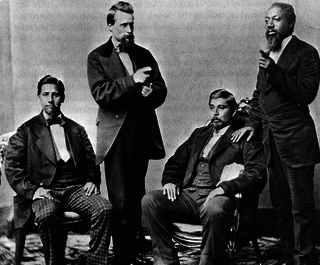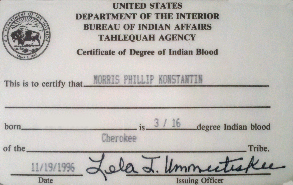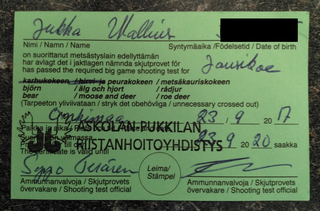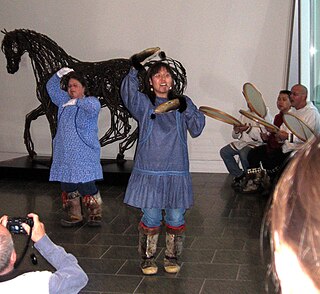
The United States Fish and Wildlife Service is a U.S. federal government agency within the U.S. Department of the Interior which oversees the management of fish, wildlife, and natural habitats in the United States. The mission of the agency is "working with others to conserve, protect, and enhance fish, wildlife, plants and their habitats for the continuing benefit of the American people."
The Migratory Bird Treaty Act of 1918 (MBTA), codified at 16 U.S.C. §§ 703–712, is a United States federal law, first enacted in 1918 to implement the convention for the protection of migratory birds between the United States and Canada. The statute makes it unlawful without a waiver to pursue, hunt, take, capture, kill, or sell nearly 1,100 species of birds listed therein as migratory birds. The statute does not discriminate between live or dead birds and also grants full protection to any bird parts including feathers, eggs, and nests. A March 2020 update of the list increased the number of species to 1,093.

Blood quantum laws or Indian blood laws are laws in the United States that define Native American status by fractions of Native American ancestry. These laws were enacted by the federal government and state governments as a way to establish legally defined racial population groups. By contrast, many tribes do not include blood quantum as part of their own enrollment criteria. Blood quantum laws were first imposed by white settlers in the 18th century. Blood Quantum (BQ) is a very controversial topic.

The Navajo Nation Zoological and Botanical Park is located in Window Rock, Arizona, the capital of the Navajo Nation. It is the only tribally owned zoological park in the United States and is notable among zoological facilities in that it labels its exhibits in the Native American Indian language of Navajo. Having been operated by the Navajo Nation Parks & Recreation Department since its inception in the early 1960s, it became part of the Navajo Nation Department of Fish and Wildlife in September 2006.

War bonnets are feathered headgear traditionally worn by male leaders of the American Plains Indians Nations who have earned a place of great respect in their tribe. Originally they were sometimes worn into battle, but they are now primarily used for ceremonial occasions. In the Native American and First Nations communities that traditionally have these items of regalia, they are seen as items of great spiritual and political importance, only to be worn by those who have earned the right and honour through formal recognition by their people.

A Certificate of Degree of Indian Blood or Certificate of Degree of Alaska Native Blood is an official U.S. document that certifies an individual possesses a specific fraction of Native American ancestry of a federally recognized Indian tribe, band, nation, pueblo, village, or community. They are issued by the Bureau of Indian Affairs after the applicant supplies a completed genealogy with supporting legal documents such as birth certificates, showing their descent, through one or both birth parents, from an enrolled Indian or an Indian listed in a base roll such as the Dawes Rolls. Blood degree cannot be obtained through adoptive parents. The blood degree on previously issued CDIBs or on the base rolls in the filer's ancestry are used to determine the filer's blood degree. Information collected for the filing is held confidential by privacy laws, except if the CDIB is related to assigned duties.

The eagle bone whistle is a religious object, used by some members of Native American spiritual societies in sacred ceremonies. They are made from bones of either the American bald eagle or the American golden eagle, and are considered powerful spiritual objects.

A hunting license or hunting permit is a regulatory or legal mechanism to control hunting, both commercial and recreational. A license specifically made for recreational hunting is sometimes called a game license.
Cherokee heritage groups are associations, societies and other organizations located primarily in the United States. Such groups consist of persons who do not qualify for enrollment in any of the three federally recognized Cherokee tribes. As the Cherokee Nation enrolls all people who can prove descent from a Cherokee ancestor, many of these groups consist of those who claim Cherokee ancestry but have no documentation to prove this alleged heritage. Some have had their claims of ancestry checked and proven to be false. A total of 819,105 Americans claimed Cherokee heritage in the 2010 Census, more than any other named tribe in the Census.

Native American identity in the United States is a community identity, determined by the tribal nation the individual or group belongs to. While it is common for non-Natives to consider it a racial or ethnic identity, for Native Americans in the United States it is considered to be a political identity, based on citizenship and immediate family relationships. As culture can vary widely between the 574 extant federally recognized tribes in the United States, the idea of a single unified "Native American" racial identity is a European construct that does not have an equivalent in tribal thought.

Native American recognition in the United States, for tribes, usually means being recognized by the United States federal government as a community of Indigenous people that has been in continual existence since prior to European contact, and which has a sovereign, government-to-government relationship with the Federal government of the United States. In the United States, the Native American tribe is a fundamental unit of sovereign tribal government. This recognition comes with various rights and responsibilities. The United States recognizes the right of these tribes to self-government and supports their tribal sovereignty and self-determination. These tribes possess the right to establish the legal requirements for membership. They may form their own government, enforce laws, tax, license and regulate activities, zone, and exclude people from tribal territories. Limitations on tribal powers of self-government include the same limitations applicable to states; for example, neither tribes nor states have the power to make war, engage in foreign relations, or coin money.

The Bald and Golden Eagle Protection Act is a United States federal statute that protects two species of eagle. The bald eagle was chosen as a national emblem of the United States by the Continental Congress of 1782 and was given legal protection by the Bald Eagle Protection Act of 1940. This act was expanded to include the golden eagle in 1962. Since the original Act, the Bald and Golden Eagle Protection Act has been amended several times. It currently prohibits anyone, without a permit issued by the Secretary of the Interior, from "taking" bald eagles. Taking is described to include their parts, nests, or eggs, molesting or disturbing the birds. The Act provides criminal penalties for persons who "take, possess, sell, purchase, barter, offer to sell, purchase or barter, transport, export or import, at any time or any manner, any bald eagle ... [or any golden eagle], alive or dead, or any part, nest, or egg thereof."

The Native American Church (NAC), also known as Peyotism and Peyote Religion, is a syncretic Native American religion that teaches a combination of traditional Native American beliefs and elements of Christianity, especially pertaining to the Ten Commandments, with sacramental use of the entheogen peyote. The religion originated in the Oklahoma Territory (1890–1907) in the late nineteenth century, after peyote was introduced to the southern Great Plains from Mexico. Today it is the most widespread indigenous religion among Native Americans in the United States, Canada, and Mexico, with an estimated 300,000 adherents.

The National Eagle Repository is operated and managed under the Office of Law Enforcement of the United States Fish and Wildlife Service located at the Rocky Mountain Arsenal National Wildlife Refuge outside of Denver, Colorado. It serves as a central location for the receipt, storage, and distribution of bald and golden eagles that have been found dead. Eagles and eagle parts are available only to Native Americans enrolled in federally recognized tribes for use in religious and cultural ceremonies.

The United States Fish and Wildlife Service Office of Law Enforcement contributes to Service efforts to manage ecosystems, save endangered species, conserve migratory birds, preserve wildlife habitat, restore fisheries, combat invasive species, and promote international wildlife conservation. It is an office of the United States Fish and Wildlife Service (FWS).

A bill to amend the Migratory Bird Treaty Act to exempt certain Alaskan Native articles from prohibitions against sale of items containing nonedible migratory bird parts, and for other purposes was a proposed law that would have allowed Alaskan Natives to make and sell traditional handicrafts such as masks, jewelry, clothing, and hunting equipment that are made from parts of migratory birds, particularly feathers.
United States v. Antelope, 430 U.S. 641 (1977), was a United States Supreme Court case in which the Court held that American Indians convicted on reservation land were not deprived of the equal protection of the laws; (a) the federal criminal statutes are not based on impermissible racial classifications but on political membership in an Indian tribe or nation; and (b) the challenged statutes do not violate equal protection. Indians or non-Indians can be charged with first-degree murder committed in a federal enclave.
Cherokee descent, "being of Cherokee descent", or "being a Cherokee descendant" are all terms for individuals with some degree of documented Cherokee ancestry but do not meet the criteria for tribal citizenship. The terms are also used by non-Native individuals who self-identify as Cherokee despite lacking documentation or community recognition.
Robert Soto is an American, religious leader, Tribal Council vice chairman, feather dancer, and activist who is a member of the Lipan Apache Tribe of Texas and serves as their council's vice chairman. He is best known for a series of successful legal challenges to oppose laws that have both restricted and criminalized eagle feather possession by Native Americans. The basis for his position is that possession of eagle feathers is an expression of Native American religious freedom.

Arvol Looking Horse is a Lakota Native American spiritual leader. He is the 19th keeper of the Sacred White Buffalo Calf Pipe and Bundle.













